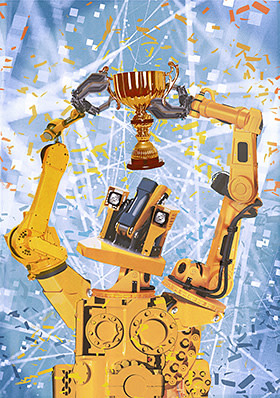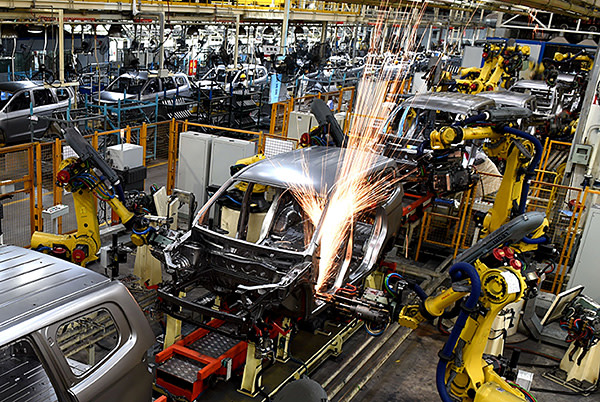Drivers of change: Fanuc
Roula Khalaf, Editor of the FT, selects her favourite stories in this weekly newsletter.
Since Fanuc’s founder Seiuemon Inaba built its corporate HQ at the foot of Mount Fuji in the 1980s, the world’s biggest robot company has been used to guarding its secrets with military precision.
Employees work inside the “Fanuc forest”, an isolated world where almost everything from robots, factory buildings to workwear are coloured in bright yellow. Today the company is busily expanding a gym and constructing a soccer field as well as a tennis court to ensure its workers are happy inside the confines of its reclusive corporate home.
“The market we are competing in is similar to combat,” Yoshiharu Inaba, Fanuc’s chief executive and the 67-year-old son of the company’s founder, told the FT last year. In the global market for industrial robots, Fanuc competes with three other big players: Japan’s Yaskawa Electric, Switzerland’s ABB and Germany’s Kuka.
Wearing his bright yellow jacket, Inaba added: “When we are at war, information such as what kinds of products are sold in which markets and how profitable they are, or how we produce them inside our factories, is the same as military secrets.”
Shareholders have dealt with Fanuc’s secretive culture by consulting suppliers, clients and rivals to compensate for curt quarterly updates and lack of access to senior management. In 2010, in the aftermath of the global financial crisis, the company shocked investors by terminating earnings briefings at its headquarters. It told investors it needed to focus on its business.
So when Third Point — the US hedge fund run by Daniel Loeb — disclosed in February last year that it had bought a stake in Fanuc, most observers of Fanuc affairs braced for an epic clash of cultures across the Pacific. Few anticipated any Fanuc response as the activist investor sent a letter to the company, urging it to make better use of its massive cash pile by buying back shares.
“Fanuc is an incredibly focused company operationally, but the company trades at a low valuation because they have not moved forward with the society in respecting shareholders and in implementing better capital allocation,” Loeb told the FT.

Yet in a matter of two months, the most unlikely change took place. Fanuc established a division for investor relations to improve dialogue and announced the appointment of two outside directors.
Long-term investors were given plant tours and one-on-one meetings with senior management. Topping it all, the robot maker promised to double its dividend payout ratio and carry out “flexible” share buybacks.
Shareholders responded by giving a 43 per cent boost to Fanuc’s stock price during the first four months of 2015. “When a big Japanese company like Fanuc, which is known for being less communicative, announced the change, it was very good news for the stock market since it showed that corporate Japan is changing,” said Steve Glod, a fund manager at Banque de Luxembourg Investments, which has been an investor in Fanuc since 2011.
Fanuc’s change of heart came in the midst of a mini-revolution in Japanese business practices. Last year, the country established new corporate governance and stewardship codes, which were strongly advocated by prime minister Shinzo Abe. Companies were encouraged to disburse cash and be more receptive to shareholder demands for better returns.
Abe’s push has had mixed success. Leading companies on the Tokyo stock exchange bought back a record Y4.8tn ($42bn) in shares in 2015, topping the previous peak of Y4.2tn in 2007, according to Goldman Sachs. But for all the talk of returns on equity, average ROEs for Japanese companies remain below 8 per cent, compared with 16 per cent for US companies.
“I think Abenomics definitely helped Fanuc to open up,” says Keita Kubota, Tokyo-based investment manager at Aberdeen Investment Management, referring to Abe’s economic programme to lift Japan out of deflation. “But as we can see from past reforms, these changes won’t happen overnight. You have to be patient. This is Japan.”
Even as some foreign investors enthusiastically view Fanuc’s move as a cue to invest in Japanese equities, Inaba says the company has been fighting a completely different battle. In opening itself up, it wanted to alter the widespread perception that it was a mysterious organisation hidden inside what some people called a “yellow kingdom”.
“We are not a yellow cult group or a reclusive, secretive society,” Inaba says. “That kind of an image is extremely negative to Fanuc.”
Yet as reporters these days are taken inside Fanuc’s vast campus-like property in central Japan’s Yamanashi prefecture, it is hard to ignore the oddities.
Beyond the entrance guarded by two statues of Japanese Shinto gods, staff move around in yellow buses and cars. Receptionists are dressed in yellow, the calendars on the walls are yellow and the hand towels that are handed out are yellow, too.
The colour has been a powerful marketing tool for Fanuc, which spun out of Japanese electronics maker Fujitsu in 1972. Nearly 40 years ago, Inaba’s father — his favourite colour is actually blue — adopted yellow because of its bright stand-out qualities. True enough, people worldwide immediately recognise Fanuc’s robot armies without needing to check labels.
Present-day chief executive Inaba has insisted that the company’s new shareholder-friendly policies are not related to pressures from Loeb.

When asked if he feels compelled to communicate with investors, a disgruntled look flashes across his face. “I feel uncomfortable when you put it that way. I don’t have an obligation,” he says.
He still prefers to devote his time to meeting clients ranging from Apple, to Samsung to Tesla. But in his dialogue with shareholders, he has also found that their thinking as investors is not far apart from the company’s stance.
To his surprise, few of them have made what he might regard as unreasonable demands in terms of capital allocation. Many have understood the need for Fanuc to maintain investment in new businesses and plants, even though, for example, its cash pile of $8.9bn last year seemed more than enough for that.
“Currently there has been a lot of attention in Japan on delivering higher returns to shareholders through dividends and share buybacks,” says Glod. “But Fanuc has always excelled in the past even when its payout ratio was low because it creates value for shareholders by ensuring profitable growth and doing many things right in its business.”
Fund managers such as Glod and Kubota have been investing in Fanuc since long before its new disclosure policy. Even with limited access to information, Inaba’s ultra-focused management meant the company churned out operating profits of 35 per cent. In the 2014/15 fiscal year, its net profit rose 87 per cent to Y208bn.
But its stellar performance will not last forever. Shares in Fanuc have fallen 40 per cent from their peak last April as investors worry about a slowdown in the Chinese economy and declining sales of its Robodrill machine tools, which are used to make metal cases for iPhones and other smartphones. The company, valued at $31bn, expects a 24 per cent fall in net profit for the current financial year through to March.
Inaba appears unfazed. The company has overcome problems in the past by adapting to market changes. As a new endeavour, Fanuc recently acquired a small stake in Preferred Networks, a Tokyo-based machine learning company that is working to apply artificial intelligence to robots and autonomous driving systems.
Perhaps one of its biggest changes last year was the appearance of Fanuc’s first robot that is not yellow. Its “collaborative” industrial robot, the green CR-35iA, is installed with sensors and other safety technologies that allow it to stop immediately when it comes in contact with a human being.
“I made it wear a green jacket so people can immediately recognise it as safe,” Inaba says with a chuckle. “Inside, it is still a yellow robot.”
Despite his criticisms of Fanuc’s cash pile, Loeb also does not hide his fascination for the company’s innovative spirit.
“Fanuc can be inward-looking and not communicative,” he says. “But I do think embedded somewhere in their culture is a willingness to look forward.”
Comments